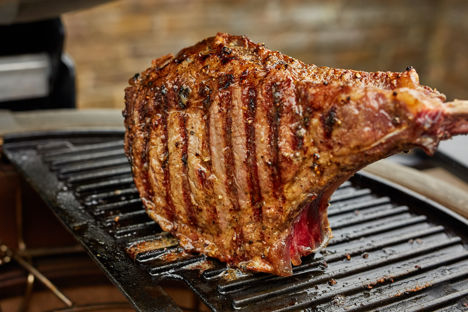Barbecuing gives a charred, smoky quality to food that is irresistible. Not just for steaks, burgers and sausages, many foods can benefit from cooking over coals in the midst of smoke and ash. Learn a few basic barbecue techniques and you will be dining al fresco all summer long.
Types of barbecue
There are three types of barbecue – charcoal, gas and electric.
A charcoal grill is considered the true barbecue – the traditional use of coal giving a fantastic smoky flavour. The cooking temperature is hard to control with temperatures reaching up to 400˚C so careful timing is required.
With a gas or electric barbecue, the temperature is easy to regulate as it can be turned up and down. It doesn’t require a great deal of preheating unlike a charcoal barbecue. The biggest pitfall of gas and electric barbecues is the lack of smoke flavour in the finished dish. This can be overcome in part by adding wood chips or bunches of herbs to the grill before cooking. You will need to soak them in water for at least 20 minutes beforehand to prevent scorching.
Before using a barbecue, ensure that all surfaces are debris and grease free, especially if your barbecue has been sitting under a cover for the last 9 months. Make sure that the barbecue is preheated before putting on your food in order to achieve those signature char marks.
Cooking techniques
A barbecue is good for both direct and indirect cooking (the barbecue must have a lid for this). Direct cooking is best for foods that require relatively short cooking times such as steak, prawns and small pieces of meat like chicken kebabs. The food is put over a high heat and cooks quickly. Don't put food on to a barbecue that is still flaming as fat drips from meat it will flare up and give a burnt taste to food.
Indirect cooking involves using your barbecue in a similar way to an oven – you cook food on a higher shelf with the lid down at a lower temperature for a longer time. This is suited for large cuts of meat such as ribs, legs and shoulders. This is also a good way of cooking vegetables and fish wrapped in foil.
Safety considerations
Where there's smoke, there's fire and where there's fire, there's danger . . . Always take the necessary precautions when barbecuing. Make sure the barbecue is on a flat, stable surface away from plants, table cloths, children and pets. Never leave the barbecue unattended or try to move it until it has completely cooled. It is wise to keep a bucket of water close at hand.
For gas barbecues, take care when changing the gas cylinders and always make sure the gas has been turned off when you have finished cooking.
It is advisable to use a cooking thermometer when barbecuing meat to ensure that the correct internal temperature to kill any bacteria has been reached. If you don’t have a thermometer, check that meat (especially chicken and pork) is cooked by inserting a knife into the meat – the juices should run clear.
Uses
The flavour of meat and fish can be enhanced by the use of a rub, marinade or sauce. When using sugary sauces, be careful as these will burn quickly. Adam Gray marinates pork belly in beer, garlic and bay before char-grilling whereas Josh Eggleton glazes duck breast with honey, Chinese five spice and sherry vinegar and serves them with a crunchy white coleslaw.
Fish needs a careful eye on the barbecue but the results can be fantastic. Try Paul Ainsworth's Barbecued mackerel with celeriac mayonnaise or Robert Thompson's Grilled sardines on ciabatta with tomato confit, basil and tapenade.
Vegetables are also great barbecued as Galton Blackiston demonstrates in his Barbecued asparagus with rapeseed mayonnaise. And don't overlook cheese – Alfred Prasad makes these tasty Paneer and red pepper skewers which are perfect for sizzling. Have a look at our suggestions for side dishes that go well with barbecued food.
Get in touch
Please sign in or register to send a comment to Great British Chefs.



